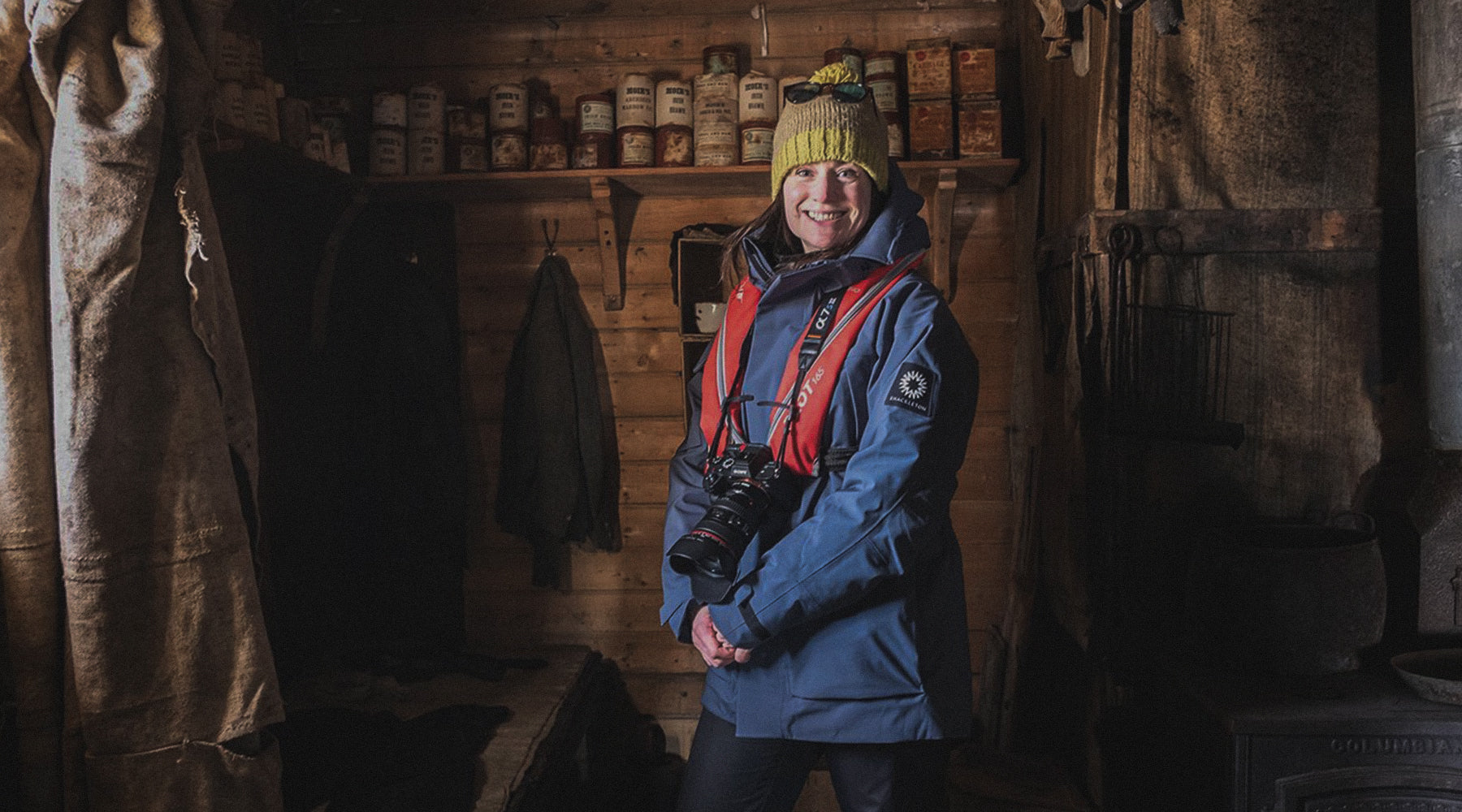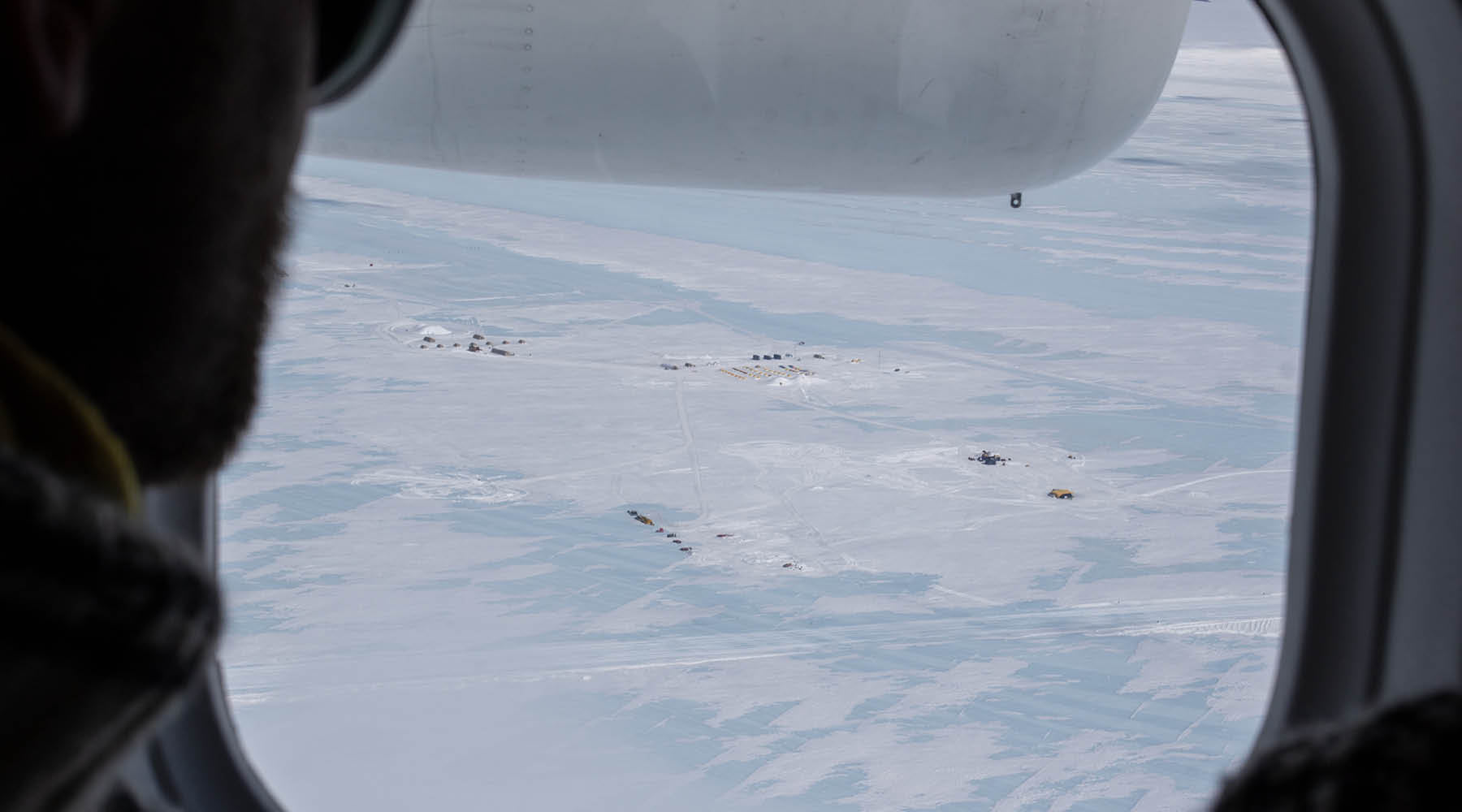
Daring to do what scares me – an interview with filmmaker Natalie Hewit
Natalie Hewit was the only film director on board the SA Agulhas II when the Endurance was discovered in 2022. Here she talks about her love of Antarctica, dealing with the dynamics of a ship, and what she learnt from Shackleton as a filmmaker.
The phone call that would change Natalie Hewit’s life came completely out of the blue. "An old boss of mine got in touch,” she recalls. "He said, ‘Do you want to go to Antarctica on your own for three months to direct a film for the BBC? I need to know by tomorrow lunchtime.’” Her eyes spark. “My first reaction was that I didn’t want to go. But I’d wanted to move from producing to directing for a long time and I could see this would be the break I’d been looking for. I was also in a phase of my life where I was determined to do things that scared me. So I told him I would do it.”

Weeks later she was surveying the stark, otherworldly beauty of the continent that would – as it has with so many people – draw her back again and again. Her mission on this first visit was to document the operation to move the Halley VI polar research station, which was in danger of floating away from Antarctica following the appearance of a large crack in the Brunt Ice Shelf where it was based. It was utterly alien to anything she had experienced before, but she confesses, “I was surprised at how quickly everything felt normal – going to breakfast on a Ski-Doo and managing the logistics of filming in sub-zero temperatures. When I first arrived, I thought, ‘how am I ever going to learn the 70 names of the people who were living and working there? Within a week, I knew them all, and I also knew the names of their partners at home. You become part of this bizarre, slightly dysfunctional family.”
Ice Station Rescue
We are talking in the comparatively un-icy surroundings of St James’ Park in London, where Hewit has agreed to meet for a coffee despite being in a whirlwind of preparations to leave for Antarctica again to lecture on a cruise. That first documentary that she made – Ice Station Rescue, which hauntingly evoked the spell that Antarctica had cast over Halley’s inhabitants while simultaneously detailing the riveting, down-to-earth detail of their lives – was nominated for Best Documentary at the Broadcast Awards. Yet we are here to discuss the vital role that she played as the only film director who was on board the South African ice-breaking polar supply ship, the SA Agulhas II, when Ernest Shackleton’s Endurance was located on March 5 2022. Thanks to Hewit’s round-the-clock dedication and fearless determination to film every aspect of what happened – not always easy when people were under pressure – the world could witness the extraordinary ups and downs leading to one of the most historic shipwreck discoveries of our time.
Dan Snow – who was famously on board providing his knife-sharp, energetic commentary on the expedition’s progress – has been a long-term fan of Hewit and her work. “She’s one of those brilliant documentary makers who’s as skilful at managing the camera and the kit as she is at managing relationships,” he says on the phone to me just before Christmas. The two of them first met when Hewit directed Snow in Operation Gold Rush, “Nothing was impossible for her – she’s the kind of person to whom you can say, ‘Can you cross these mountains, transport a specially made replica boat, send it down the rapids and help find lots of gold in the Yukon by using nineteenth century techniques?!’ Her attitude was always ‘we can get this done’.”
Defying the odds
It was entirely typical, then, that Hewit took the risk when Snow told her that John Shears and Mensun Bound were leading the expedition to search for the Endurance and needed a filmmaker. “I really felt the weight of taking on the assignment, not just because it's an important story but because so many people take such hope from it whenever they hear it,” she declares. “Including myself – it's been a such a source of inspiration when I’ve faced unspeakable odds.” Not least of the tensions was the fact that as recently as 2019 an expedition – also led by Shears – had failed to find the Endurance. Yet from a filmmaker’s perspective, each dive by the underwater drone had to be recorded as if this might be the one that yielded the result that many on the crew had spent most of a lifetime waiting for.

Sometimes, inevitably, emotions ran high. Part of what’s so fascinating about the finished film is that Hewit had won enough trust from people on board the SS Agulhas II for them to treat her – and by extension the camera – as a confidante. “She has a way of letting people talk and then not filling the silence,” says Snow. “Because she’s friendly and engaged that encourages them to talk more.”

The psychological challenges were compounded by the technical challenges of filming in sub-zero temperatures. Yet she and her team were determined and ended up collecting more than 800 hours of footage. The moment of discovery was almost like a shock. “When I finally saw the grainy image of the Endurance on the underwater camera,” Hewit declares, “I thought, ‘This can’t possibly be true’. It felt like some kind of miracle.”
Expanding the team
There was excitement when it was announced – after the discovery – that the Oscar-winning husband and wife filmmaking team, Jimmy Chin and Chai Vasarhelyi were coming in to co-direct the film. Hewit was well aware there was a lot of work still to be done. Back in the UK she flung herself into gathering more material. Though she had done research before joining the expedition, she and a producer, Cameron Powrie, who she describes as “incredibly talented,” now tracked down and read every single diary that the individuals on Shackleton’s crew had written.
In contrast to films she’d seen about Shackleton, where the emphasis was on the hardship of what the men were going through, the diaries were “so much more nuanced. There was levity and there was joy, and there was banter.” She became obsessed by whether there was a better way to communicate each person’s thoughts than asking actors to read the diaries out. Then Powrie found some recordings of the crew in the British Library sound archive and Hewit realised there was a possibility that Shackleton’s men could tell the story themselves.
Yet after an extensive search, “I was literally visiting their relatives and going through their attics,” she realised there wasn’t enough historic recorded material for what was needed. The turning point came when a producer asked if she had seen A Life Uncharted, the documentary about Thunderbirds creator Gerry Anderson that used AI to recreate his voice. “We had the crew members’ words in their diaries and we could sample their voices,” Hewit declares. “We were able to work with an AI company in Ukraine which has very strict protocols on ethics, and we had of course spoken to all the crew family members. So I realised that more than a century afterwards we could bring the two together which was amazing.”
Weaving together the layers
Anyone who has watched Endurance is aware of what a gripping piece of storytelling it is. With consummate skill it weaves together Frank Hurley’s original film from the Endurance expedition, recreations of what happened to Shackleton and his men, Daniel Pemberton’s stunning score, and the footage that Hewit brought from the SA Agulhas II. The AI recreations of the men’s voices – that could, if wrongly done, have come across as clunky – here prove to be the coup de grace. You really feel as if you are eavesdropping on history, sense the shiver of the past going down your spine.
Life lessons in extreme environments
The overall experience has reinforced Hewit’s love of working and filming in extreme environments. She had a baptism of fire when, in the first film that she made with Snow in the Yukon, she survived a close encounter with a black bear. “At first it didn’t see me, so – after thinking back to my survival training course – I realised I could retreat. Then it turned around, and though I know you should never run from a bear my legs took over. Thankfully it didn’t follow me.” The close encounter didn’t deter her in the slightest. “I love the team dynamic that you build when you're on a demanding expedition,” she says. “Those bonds that you form last much longer than many other friendships or bonds with work colleagues.”

It’s a sentiment that Shackleton would undoubtedly have agreed with. What did she take from spending so much time researching his most famous expedition? “My favourite thing is that he was a great leader despite being so full of self-doubt,” she replies. “Even though he worried he wasn’t going to be good enough all the time, he was faithful to his intentions and just kept going.”
His philosophy is one that she feels applies equally well to filmmaking. “I want to explore what it means for us to be humans on this planet. What makes us tick and what can hopefully help us to heal. That’s one of the things that I absolutely loved about making a film about the Endurance 22 expedition. These stories show us what we can achieve when we work together.”
By Rachel Halliburton


